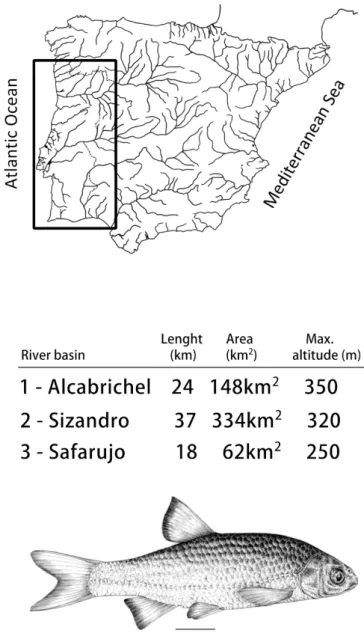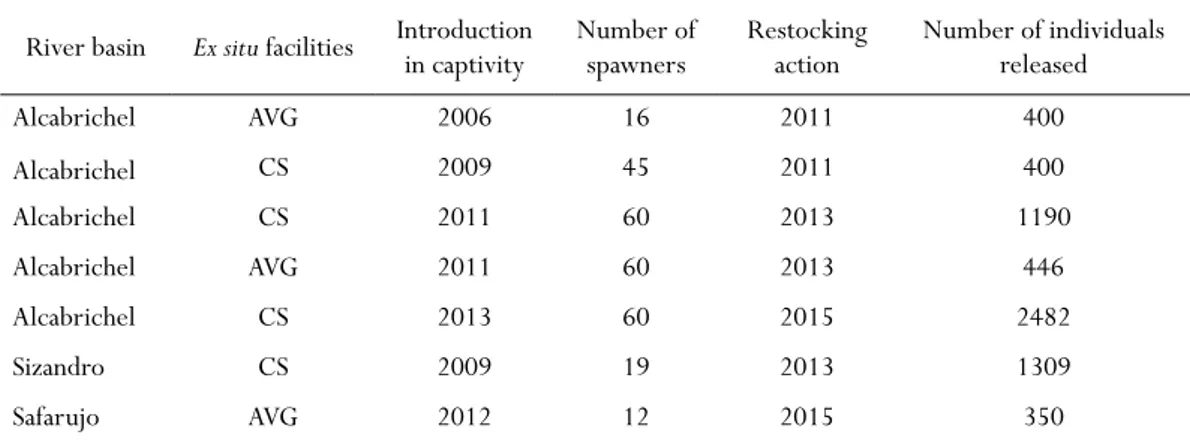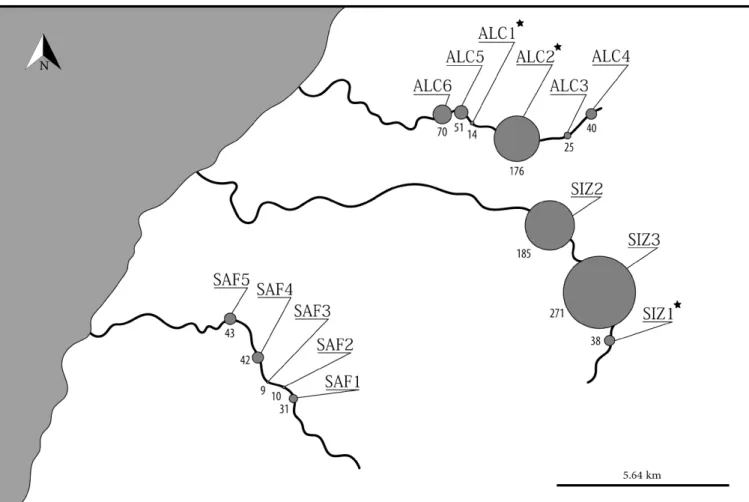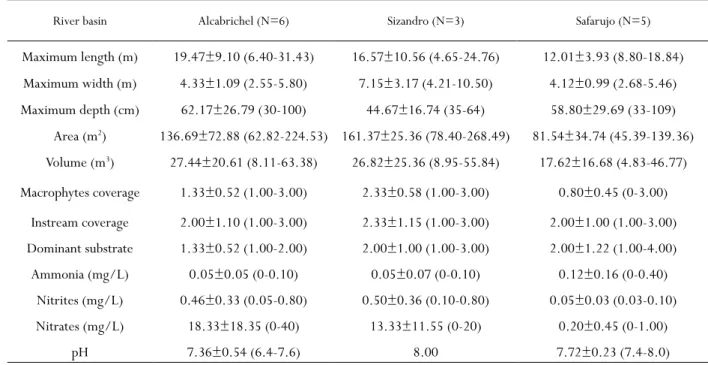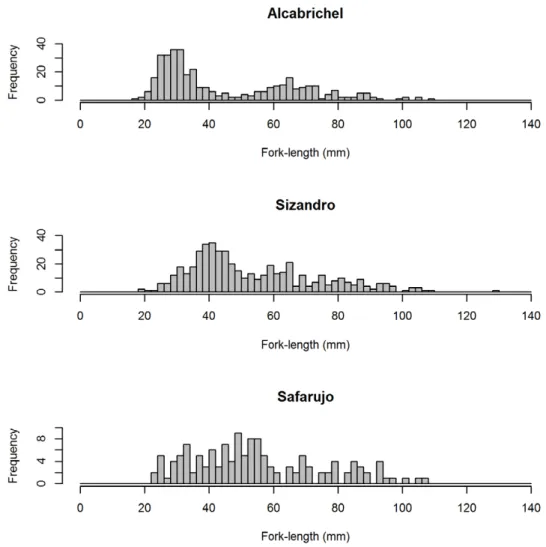DOI - 10.21707/gs.v10.n02a01
C
onservationoftheCritiCallyendangeredA
chondrostomAoccidentAle(P
isCes: C
yPrinidae):
integratinghabitatdatainrestoCkingProgramstoimProvePoPulationreCoverymameri d1; sousa-santos C2*; magalhães mf1 & robalo Ji2
1Centro de Biologia Ambiental, Faculdade de Ciências, Universidade de Lisboa, Lisboa, Portugal 2 MARE, ISPA – Instituto Universitário, Lisboa, Portugal
* Corresponding author: carla.santos@ispa.pt
Recebido em 15 de dezembro de 2015. Aceito em 18 de junho de 2016. Publicado em 09 de dezembro de 2016.
Resumen – La fauna ciprinícola endémica de la Península Ibérica enfrenta actualmente varias amenazas de origen humana que realzan su riesgo de extinción.
Las poblaciones de Achondrostoma occidentale, espécie en peligro crítico que ocurre sólo en tres pequeñas e intermitentes cuencas portuguesas, se han reforzado con peces criados ex-situ con el fin de minimizar su riesgo de extinción. Este trabajo tuvo como objetivo describir las acciones de repoblación llevados a cabo y identificar y caracterizar los refugios de verano que deberían posteriormente ser restaurados y repoblados. Los resultados indican incrementos poblacionales y una alta representatividad de las clases de edad más jóvenes en las poblaciones repobladas. Se resalta la importancia de las monitorizaciones anuales de la abundancia de peces para evaluar la forma de la especie hacer frente a los factores estocásticos y deterministas estresantes que pueden llegar a poner en peligro su supervivencia.
Palabras Clave: ConservaCiónex-situ, supportivebreeding, arroyosintermitentes, refugiosdeverano
abstraCt – Cyprinid fauna endemic to the Iberian Peninsula is currently facing several human-caused threats which enhance their risk of extinction.
The populations of the critically endangered Achondrostoma occidentale, occurring only in three small and intermittent Portuguese river basins, have been reinforced with fish bred ex-situ in order to minimize their risk of extinction. This study aimed to describe the restocking actions conducted and to identify and characterize the summer refugia that should become targets for restoration and further restocking. The results evidence population increments and a high representativeness of younger age classes in the restocked populations. The importance of annual monitoring of fish abundance to assess how the species is coping with the stochastic and deterministic stressors that may eventually compromise its survival is highlighted.
key Words: ex-situConservation, supportivebreeding, intermittentstreams, summerrefugia
Resumo – A fauna ciprinícola endémica da Península Ibérica enfrenta actualmente várias ameaças de origem antropogénica que potenciam o seu risco de
extinção. As populações de Achondrostoma occidentale, espécie criticamente em perigo que ocorre apenas em três bacias portuguesas intermitentes e de reduzida dimensão, foram alvo de um reforço com peixes criados ex-situ de modo a minimizar o seu risco de extinção. Este estudo teve como objectivos descrever as acções de monitorização efectuadas e identificar e caracterizar os pegos estivais que deverão ser alvo de futuras acções de restauro e repovoamento. Os resultados obtidos evidenciam incrementos populacionais e uma maior representatividade das classes de menor tamanho nas populações repovoadas. É salientado o importante papel das monitorizações anuais para avaliação da forma como a espécie reage aos constrangimentos estocásticos e determinísticos que podem eventualmente comprometer a sua sobrevivência.
Palavras-Chave: Conservaçãoex-situ, supportivebreeding, riosintermitentes, refúgiosestivais
ConservaçãodaesPéCieCritiCamenteameaçada AchondrostomAoccidentAle (PisCes: CyPrinidae): integrandodadosdehabitatem
ProgramasdereabasteCimentoParamelhorarareCuPeraçãodaPoPulação
ConservaCióndel AchondrostomAoccidentAleenPeligroCrítiCo (PisCes: CyPrinidae): integraCióndedatosdehábitatenProgramas
derePoblaCiónParameJorarlareCuPeraCióndelaPoblaCión
i
ntroduCtionConservation status of Iberian cyprinids
Freshwater fishes are among the most threatened organisms in the world (Duncan and Lockwood 2001, Carrizo et al. 2013). Cyprinids belong to the most diverse family, with a worldwide distribution (Nelson 2006) and some of the world’s most threatened species (Duncan & Lockwood 2001).
In the Iberian Peninsula, the cyprinid fauna includes a large proportion of endemic species (Doadrio et al. 2011), most of which highly threatened (Smith and Darwall 2006, Hermoso and Clavero 2011). Indeed, the proportion of
threatened species in this region is amongst the highest recorded in the IUCN assessment of the conservation status of freshwater fishes in Europe (Freyhof and Brooks 2011). Iberian cyprinids are vulnerable to several human-caused threats, including pollution, damming, water abstraction, and the spread of exotic species (Cabral et al. 2005). Additionally, they generally display low genetic diversity (Sousa-Santos et al. 2014) and small geographic distribution ranges (Cabral et al. 2005, Doadrio et
al. 2011), which enhance their risk of imperilment. Currently, 26 out of the 38 species of Iberian cyprinids raise some level of conservation concern (Cabral et al. 2005, Doadrio et al. 2011). The western ruivaco Achondrostoma occidentale
The western ruivaco Achondrostoma occidentale is a small cyprinid (<100 mm fork length) endemic to Portugal (Robalo et al. 2005). It has a reduced geographic range, occurring only in three small independent basins in the western slope of Portugal: Alcabrichel, Sizandro and Safarujo (Figure 1).
These small streams, ranging from 18 to 37 km in length (Figure 1), are subjected to highly seasonal flows, with almost no flow in the summer and large floods in winter. During the summer, the streams often dry, resulting in a series of disconnected pools, which may act as refugia for fish and as sources of recruits or colonists for the entire system after flow resumption at the end of the dry season. Moreover, these streams face strong habitat destruction and pollution, especially due to sewage from pig farms, distilleries, and agricultural and urban discharges (Robalo et al. 2005, 2008). The Alcabrichel River
from the ancestral lineage, which gave rise to the remaining Achondrostoma species, prior to the Messinian Salinity crisis (more than 7 million years ago) (Robalo et al. 2006). A recent genetic survey revealed that A. occidentale populations are currently genetically depleted, showing an average haplotype diversity of 0.31±0.44 (Sousa-Santos et al. 2013).
was recently classified as highly degraded, based on the results obtained for the biotic index based on macroinvertebrates IBMWP (Teixeira et al. 2008).
Phylogenetically, A. occidentale is close to Achondrostoma sp. from the northwestern margin of Iberia (Robalo et al. 2006). Based on the mutation rate of the cytochrome b gene, their common ancestor is expected to have diverged
Figure 1 - River basins inhabited by the Achondrostoma occidentale are presented:
main course length (in km), area (in km2) and maximum altitude (in m). [Illustration by Clara Almada]
Captive breeding as a preventive measure for the conservation of A. occidentale
After the description of the species, surveys were
conducted in 2005 and 2006 in the Sizandro, Alcabrichel and Safarujo rivers. These surveys revealed that populations were small and fragmented (C. Sousa-Santos unpublished data). Moreover, a severe drought was in course at the time (García-Herrera et al. 2007), and long river stretches were
already dry, increasing the risk of loss of individuals and local extinctions. In these circumstances, stocks of adult individuals from the Alcabrichel and Sizandro rivers were captured and maintained in tanks at the Vasco da Gama’s Aquarium as an extreme safeguard measure (Sousa-Santos et al. 2014). The spontaneous reproduction of these fish in captivity (Gil et al. 2010) prompted the launching of an ex-situ Conservation Program, targeting A. occidentale and other five highly threatened cyprinids (Sousa-Santos et al. 2014).
history (Robalo et al. 2007, Karaiskou et al. 2011, Kitanishi et al. 2013), behaviour (Sutherland 1998, Robalo et al. 2007, Ozer & Ashley 2013) and habitat use (Santos and Ferreira 2008, Martelo et al. 2014). In particular, it would be essential to understand which habitats favour the persistence of A. occidentale along the river courses during the dry season and may act as summer refugia, as those should be considered priority areas for protection/restoration and may configure potential locations for restocking actions. This study addresses this issue and, thus, the specific objectives were: i) to describe restocking actions already conducted in wild populations; and ii) to identify and characterize, across the distribution range of A. occidentale, the summer refugia that should become targets for restoration and further restocking.
m
aterialandm
ethods Captive breedingThe captive breeding of A. occidentale started in 2006, at the Vasco da Gama Aquarium, and involved (as referred above) an initial stock of 16 wild adults from the Alcabrichel River. After the official launching of the ex-situ Conservation Program, in 2009, another captive stock from the Alcabrichel River and one stock from the Sizandro River were founded at the Campelo Station facility (for a detailed description of the station please see Sousa-Santos et al. 2014). Since continuous breeding from descendants from the same initial stock may contribute to the loss of genetic diversity, all fish were released after a maximum of three consecutive generations in captivity (Sousa-Santos et al. 2014). New captive populations have been founded each two to three years after restocking actions, using 30 adults newly caught in the wild and 30 juveniles reared in captivity – see Table 1 for a summary.
Fish used in restocking actions were marked by cutting off the dorsal fin, for identification of recaptured individuals in future surveys. Fin cut off has been shown to have minor effects on fish, with scars persisting quite visible over time (Sousa-Santos et al. 2014).
Following other captive breeding programs (e.g. Bice et al. 2013), the final goal of this program was to release captive bred populations in the streams where their founders were collected, after the requalification of at least some river stretches (Sousa-Santos et al. 2014). Captive breeding has been shown to be essential in preventing the extinction of several threatened species (Adamski et al. 2007, Rakes et al. 2013), by providing a high number of offspring per generation which can be used to restock wild populations with a low effective population size (Champagnon et al. 2012).
Because avoiding artificial selection and domestication is crucial in ex-situ conservation programs aiming to restock wild populations (Saura et al. 2008), a ‘‘naturalistic approach’’ of the reproduction was adopted for A. occidentale, aiming to breed and rear fish in conditions that would preserve the natural behavioural patterns of the species (Sousa-Santos et al. 2014). This approach relied on four basic principles: 1) naturally occurring spawning (without artificial stimulation or hormonal induction); 2) availability of refuge areas for fry and juveniles; 3) natural conditions of light and temperature, essential for gonadal maturation; and 4) minimal human intervention (Sousa-Santos et al. 2014). Further details on the methods used and a description of the facilities can be found in Sousa-Santos et al. (2014).
To account for the eventual genetic diversity loss due to inbreeding and lineage sorting, two mitigation measures were adopted: captive breeding from the same initial stock was limited to three consecutive generations and, after the release of all the fish produced, new captive populations were founded from newly captured wild individuals (Sousa-Santos et al. 2014).
Ecological studies as complementary tools for A. occidentale conservation Apart from captive breeding, the adoption of effective measures towards the conservation of endangered species would benefit from multidisciplinary data on the target species, such as on its ecology (Clarkson et al. 2012), population dynamics (Magalhães et al.2003), genetics and evolutionary
Table 1 - Data on the captive breeding of A. occidentale at the Vasco da Gama Aquarium (AVG) and at the Campelo Station (CS), and on the resto-cking actions of wild populations of this species. Note: the Safarujo population was
restocked after the acquisition of the data presented in this paper.
River basin Ex situ facilities Introduction in captivity Number of spawners Restocking action Number of individuals released
Alcabrichel AVG 2006 16 2011 400 Alcabrichel CS 2009 45 2011 400 Alcabrichel CS 2011 60 2013 1190 Alcabrichel AVG 2011 60 2013 446 Alcabrichel CS 2013 60 2015 2482 Sizandro CS 2009 19 2013 1309 Safarujo AVG 2012 12 2015 350
and pH. The area and volume of pools were calculated by approximation to an ellipsoid.
r
esultsPopulation restocking
Between March 2011 and April 2015, seven restocking
actions of the wild populations were conducted, comprising the release of a total of 6577 fish reared in captivity (Table 1): four restocking actions at the Alcabrichel River (N=4918 individuals), one at Sizandro River (N=1309 individuals) and one at the Safarujo River (N=350) (Sousa-Santos et al. 2013 and unpublished data). In all cases, fish were released in upstream stretches, in areas with preserved habitats and good water quality: ALC1, ALC2, SIZ1 and SAF2 (for locations see Figure 2). It is important to note, however, that the restocking action in the Safarujo River was conducted after the collection of data presented in this paper.
As it is essential that ex-situ conservation programs are supported by habitat restoration actions, some efforts were also made concerning water quality improvement and habitat rehabilitation, especially at the Alcabrichel River, where natural engineering techniques were used to recover spawning habitats and prevent river bank erosion.
s
urveyofsummerrefugiaSummer refugia were surveyed at the end of the dry-season, immediately before the rains, between 11th September and 8th October 2014. The upper and medium courses of the Alcabrichel, Sizandro and Safarujo rivers were prospected by car in order to map (WGS84 datum coordinate system) all the pools persisting in the channel. Lower courses of these streams were not surveyed because they show high habitat degradation and poor water quality, and thus are not suitable for future restocking actions.
Persistent pools were sampled for fish and habitat conditions. Fish sampling was performed with a SAMUS725G electrofishing portable device. Each pool was slowly prospected in a zigzag manner from the downstream to the upstream edge, in order to get an estimate of the relative abundance of fish. All captured individuals were maintained in permanently aerated buckets, measured (fork length, nearest millimetre), and returned to the stream. The habitat at each pool was described using 11variables: maximum length (in meters), maximum width (in centimetres), maximum depth (in centimetres), area (in m2), volume (in m3), macrophytes coverage and in stream coverage (0: 0%, 1: <30%, 2: 30-60%, 3: >60%), dominant substrate (1: silt (4-64) µm, 2: sand (64 µm-2 mm), 3: gravel (2-64 mm), 4: cobbles (64-256 mm), 5: boulders (>256 mm), ammonia (in mg/L), nitrites (in mg/L), nitrates (in mg/L)
Figure 2 - Relative abundance of A. occidentale in persistent pools in the middle and upper courses of the Alcabrichel (ALC1 to ALC6), Sizandro (SIZ1 to SIZ3) and Sarafujo (SAF1 to SAF5). Grey circles are proportional to the number of individuals caught in each pool. * pools
Only a few persistent pools were found in the Alcabrichel (N=6), Sizandro (N=3) and Safarujo (N=5) rivers - Figure 2. These refugia ranged between 45.39 m2 (in Safarujo) and 268.49 m2 (in Sizandro) in area and between 4.83 m3 (in Safarujo) and 63.38 m3 (in Alcabrichel) in volume (Table 2).
s
ummerrefugiaThe prospected stretches in the upper and medium courses of the Alcabrichel, Sizandro and Sarafujo Rivers were approximately 13.75, 15.60 and 11.24 km long, respectivelly.
Table 2 - Habitat conditions in the summer refugia identified in Alcabrichel, Sizandro and Safarujo rivers. Values are the mean±SD and the range (minimum-maximum) for each variable.
River basin Alcabrichel (N=6) Sizandro (N=3) Safarujo (N=5)
Maximum length (m) 19.47±9.10 (6.40-31.43) 16.57±10.56 (4.65-24.76) 12.01±3.93 (8.80-18.84) Maximum width (m) 4.33±1.09 (2.55-5.80) 7.15±3.17 (4.21-10.50) 4.12±0.99 (2.68-5.46) Maximum depth (cm) 62.17±26.79 (30-100) 44.67±16.74 (35-64) 58.80±29.69 (33-109) Area (m2) 136.69±72.88 (62.82-224.53) 161.37±25.36 (78.40-268.49) 81.54±34.74 (45.39-139.36) Volume (m3) 27.44±20.61 (8.11-63.38) 26.82±25.36 (8.95-55.84) 17.62±16.68 (4.83-46.77) Macrophytes coverage 1.33±0.52 (1.00-3.00) 2.33±0.58 (1.00-3.00) 0.80±0.45 (0-3.00) Instream coverage 2.00±1.10 (1.00-3.00) 2.33±1.15 (1.00-3.00) 2.00±1.00 (1.00-3.00) Dominant substrate 1.33±0.52 (1.00-2.00) 2.00±1.00 (1.00-3.00) 2.00±1.22 (1.00-4.00) Ammonia (mg/L) 0.05±0.05 (0-0.10) 0.05±0.07 (0-0.10) 0.12±0.16 (0-0.40) Nitrites (mg/L) 0.46±0.33 (0.05-0.80) 0.50±0.36 (0.10-0.80) 0.05±0.03 (0.03-0.10) Nitrates (mg/L) 18.33±18.35 (0-40) 13.33±11.55 (0-20) 0.20±0.45 (0-1.00) pH 7.36±0.54 (6.4-7.6) 8.00 7.72±0.23 (7.4-8.0)
In average, pools in the Alcabrichel River showed the highest water volume and were the longest and deepest of all the pools sampled, while pools in the Sizandro River were the largest in area and width, the shallowest and the ones with the highest instream and macrophyte coverages (Table 2). The pools sampled in the Safarujo River were, in average, the smallest in area, volume, length and width and the ones with the lowest macrophytes coverage among all the pools sampled (Table 2). Pool substrate was dominated by silt in Alcabrichel and by sand in the Sizandro and Safarujo rivers (Table 2). The average
ammount of nitrites and nitrates was higher in the Alcabrichel and Sizandro rivers, whilst ammonia was higher in the Sarafujo (Table 2). Average pH ranged between 7.36 in Alcabrichel and 8.00 in Sizandro (Table 2). A total of 1005 individuals were caught at the 14 sampled pools (Figure 2). The number of fish per pool ranged from 9 individuals at SAF3 (River Sarafujo) to 271 at SIZ3 (River Sizandro) (Figure 2), with the average number of individuals per pool ranging between 27.0 in Safarujo and 164.7 in Sizandro (Table 3).
Table 3 - Number and fork length (FL, in mmm) of individuals of A. occidentale caught per persisting pool in the Alcabrichel, Sizandro and Safarujo rivers. Values are the mean±SD and the range (minimum-maximum) for each variable.
River basin Total No. individuals No. individuals/pool
mean±SD (min-max) FL/pool mean±SD (min-max) Alcabrichel 376 62.7±58.9 (14-176) 45.5±21.0 (18-110) Sizandro 494 164.7±117.8 (38-271) 54.1±19.5 (19-130) Safarujo 135 27.0±16.7 (9-43) 55.5±20.5 (23-107)
distributions, with modes in the 20-40 and 60-80 mm in the Alcabrichel and in the 40-60 and 60-80 mm in the Sizandro (Figure 3). Contrastingly, the distribution obtained for the Safarujo population was approximately normal, with the mode in the 40-60 mm class (Figure 3).
Fork length of the caught individuals ranged between 18 mm at Alcabrichel and 130 mm at Sizandro, with an average size per population ranging between 45.5 mm in Alcabrichel and 55.5 mm in Safarujo (Table 3). The populations from Alcabrichel and Sizandro presented bimodal length
Figure 3 - Length frequency distributions of A. occidentale in persistent pools in the Alcabrichel, Sizandro and Safarujo rivers inhabited. Size class amplitude is 2 mm. Note of caution: the scale in the ordinate differs among populations.
d
isCussionThe combination of deterministic and stochastic factors which negatively affect species survival may result in their extinction (Frankham 2005). Often the impact of these factors is evidenced by considerable reductions of the effective population size and low levels of genetic diversity (e.g. Hedrick 2001, Blomqvist et al. 2010, McCusker and Bentzen 2013). To overcome this problem and, consequently, minimize the risk of extinction, threatened populations should be reinforced, since demographic rather than genetic factors, may be of more immediate importance in the short term (Caro and Laurenson 1994, Caughley 1994, Brook et al. 2002). Indeed, populations that are declining rapidly or which are already small sized are more prone to destabilization due to interacting
stochastic processes such as unbalanced sex ratios, unstable age class distributions or habitat loss than larger populations (Lacy 2000, Brook et al. 2002). The reduction of the individual fitness due to small population size or low density (Allee effect) is frequently a problem for endangered species and, thus, restocking can be used to provide higher long-term chances of survival (Griffith et al. 1989, Champagnon et al. 2012). This supported the enhancement natural populations of A. occidentale with captive bred individuals in order to minimize current risk of extinction.
Restocking of A. occidentale populations
The severe drought that occurred nearly after the description of A. occidentale (García-Herrera et al. 2007)
summer it will be important to dredge sediments to increase depth; decrease the water temperature and evaporation rate by increasing instream coverage; limit water abstraction; prevent the discharge of pollutants; and set up surmountable transversal barriers to naturally improve oxygenation.
In future restocking actions, the fish to be released should be distributed by all the identified refugia in proportion to the water volume available at the time in each pool. These refugia are located upstream from the major sources of pollution and will desirably be considered as priority targets for future habitat restoration projects, which may increase the chances of survival of A. occidentale. Indeed, it is crucial that the supportive breeding of endangered species for restocking purposes is complemented with in situ conservation of the natural habitats so that the released fish may found favourable conditions to disperse, find food and shelter, spawn and grow to maturity.
Concluding remarks
The results obtained in this study evidence that the supportive breeding of A. occidentale for restocking purposes resulted in population increments and a high representativeness of younger age classes at the Alcabrichel and Sizandro rivers. As summer droughts increase the risk of fish loss, the identification and characterization of summer refugia used by this species provided fundamental baseline data to support future decisions and priorities regarding the implementation of habitat restoration measures and restocking actions. Finally, to assess the complete recovery of the three A. occidentale populations it is important to survey fish abundance on an annual basis in order to assess how the species is coping with the stochastic and deterministic stressors that may eventually compromise its survival.
a
CknoWledgmentsThe authors are grateful to the staff of the Vasco da Gama’s Aquarium and of the Campelo Station/Quercus Team for the maintenance of fish in captivity and for the restocking actions. This study had the support of Fundação para a Ciência e Tecnologia (FCT), through the strategic project UID/MAR/04292/2013 granted to MARE and the post-doctoral grant awarded to C. Sousa Santos (MARE-ISPA/ BPD/001/2015).
.
r
eferenCesAdamski P and Witkowski Z. 2007. Effectiveness of popula-tion recovery projects based on captive breeding. Biological
Conservation, 140:1-7.
Bice C, Whiterod N, Wilson P, Zampatti B and Hammer M. 2013. The critical fish habitat project: reintroductions of threatened fish species in the Coorong, Lower Lakes and Mur-ray Mouth region 2011-13. SARDI Research Report
Se-ries, no. 697. Adelaide, 67 p.
prevented the establishment of strong baseline data on the abundance of this species throughout its distribution range and precipitated the implementation of its ex-situ conservation as a safeguard measure (Sousa-Santos et al. 2013). Nevertheless, surveys conducted in 2006 indicated that populations were small and fragmented, with the number of fish per summer pool in the Sizandro and Alcabrichel rivers never exceeding 40 individuals and no fish being found across the Safarujo River (C. Sousa-Santos unpublished data). In 2014, much more individuals per pool were found in the Alcabrichel and Sizandro, likely reflecting the reinforcement of local populations with fish bred in captivity. Also, the bimodal length distributions obtained for these two populations are most likely related to the multiple episodes of restocking, which mostly included F1 and F2 juveniles (as a result of two generations bred in captivity).
A. occidentale individuals were also currently found in summer pools in the Safarujo River, despite no prior restocking has been conducted therein, though in lower numbers than in the Alcabrichel and Sizandro rivers and with a higher representativeness of small fish. This suggests that the local population was naturally slowly recovering after the drought and that recruitment was taking place. As the Safarujo River was restocked in 2015, future surveys will clarify if the restocking action that took place in this river contributes to an increase in frequency of fish from the lower size classes.
These signs of population increment must, however, be taken with caution since the desirable positive effect of restocking actions, habitat enhancement and water quality management must be evaluated in the medium/long term to account for the natural oscillations of abundance, associated for instance with annual hydrological conditions as found for other cyprinids endemic to Iberian streams (e.g. Magalhães et al. 2007).
Summer refugia
Summer refugia in the middle and upper courses of the Alcabrichel, Sizandro and Safarujo rivers are restricted to a few persistent pools, generally with less than 70 m3. There was, however, considerable variability in the number of fish congregated in each pool, suggesting that some pools may act as the main sources for river recolonization after the drought and should therefore be considered as potential locations for further restocking actions. This seemed to be particularly the case for pool ALC2 and SIZ3 in the Alcabrichel and Sizandro rivers, respectively, where more than 170 individuals were found. However, during severe droughts, these pools might configure precarious and unstable refugia for fish, with slight deterioration of water quality likely implying massive fish loss.
Because the water quality in the Alcabrichel, Sizandro and Safarujo rivers is still far from being good, some important habitat restoration and water management still need to be conducted in order to preserve summer refugia and, consequently, maximize the chances of recovery of A. occidentale. To improve habitat quality in the pools during the
dangered Cyprinids – Achondrostoma occidentale as a case study.
Journal of the World Aquaculture Society, 41:661-664.
Griffith B, Scott J, Carpenter J, and Reed C. 1989. Transloca-tion as a species conservaTransloca-tion tool: Status and strategy.
Sci-ence, 245:477-480.
Hedrick PW. 2001. Conservation genetics: where are we now?
Trends in Ecology & Evolution, 16:630-636.
Hermoso V and Clavero M. 2011. Threatening processes and conservation management of endemic freshwater fish in the Mediterranean Basin: a review. Marine and Freshwater
Research, 62:244-254.
Karaiskou N, Lappa M, Kalomoiris S, Oikonomidis G, Psaltopoulou C, Abatzopoulos TJ, Triantaphyllidis C and Trian-taphyllidis A. 2011. Genetic monitoring and effects of stocking practices on small Cyprinus carpio populations. Conservation
Genetics, 12:1299-1311.
Kitanishi S, Nishio M, Uehara K, Ogawa R, Yokoyama T and Edo K. 2013. Patterns of genetic diversity of mitochondrial DNA within captive populations of the endangered itasenoara bitterling: implications for a reintroduction program.
Envi-ronmental Biology of Fishes, 96:567-572.
Lacy RC. 2000. Considering threats to the viability of small populations using individual-based models. Ecological
Bul-letins, 48:39-51.
Magalhães MF, Beja P, Schlosser IJ and Collares-Pereira MJ. 2007. Effects of multi-year droughts on the fish assemblages of seasonally drying Mediterranean streams. Freshwater
Biol-ogy, 52:1494-1510.
Magalhães MF, Schlosser IJ and Collares-Pereira MJ. 2003. The role of life history in the relationship between population dynamics and environmental variability in two Mediterranean stream fishes. Journal of Fish Biology, 63:300-317. Martelo J, Grossman GD, Porto M and Magalhães MF. 2014. Habitat patchiness affects distribution and microhabitat use of endangered Mira chub Squalius torgalensis (Actinopterygii, Cy-priniformes). Hydrobiologia, 732:93-109.
McCusker M and Bentzen P. 2013. Positive relationships be-tween genetic diversity and abundance in fishes. Molecular
Ecology, 19:4852-4862.
Nelson JS. 2006. Fishes of the World, 4th edition, New Jer-sey: John Wiley & Sons, 624 p.
Ozer F and Ashley MV. 2013. Genetic evaluations of remnant and translocated shiners, Notropis heterodon and Notropis hetero-lepis. Journal of Fish Biology, 82:1281-1296.
Rakes PL, Petty MA, Chute JR, Ruble CL and Mattingly HT. 2013. Spawning and captive propagation of Blackside Dace, Chrosomus cumberlandensis. Southeastern Naturalist, 12:162-170.
Blomqvist, D., Pauliny, A., Larsson, M and Flodin, LA. 2010. Trapped in the extinction vortex? Strong genetic effects in a declining vertebrate population. BMC Evolutionary
Biol-ogy, 10:33.
Brook BW, Tonkyn DW, O’Grady JJ and Frankham R (2002) Contribution of inbreeding to extinction risk in threatened species. Conservation Ecology, 6:16.
Cabral MJ, Almeida, J, Almeida, PR, Dellinger, TR, Ferrand de Almeida N, Oliveira ME, Palmeirim JM, Queiroz AI, Rogado L and Santos-Reis M. 2005. Livro Vermelho dos Vertebrados
de Portugal, Lisboa: Instituto da Conservação da Natureza,
659 p.
Caro TM and Laurenson MK. 1994. Ecological and genetic fac-tors in conservation: a cautionary tale. Science, 263:485-486. Carrizo SF, Smith KG and Darwall WRT. 2013. Progress to-wards a global assessment of the status of freshwater fishes (Pisces) for the IUCN Red List: application to conservation programmes in zoos and aquariums. International Zoo
Yearbook, 47:46-64.
Caughley G. 1994. Directions in Conservation Biology.
Jour-nal of Animal Ecology, 63:215-244.
Champagnon J, Elmberg J, Guillemain M, Gauthier-Clerc M and Lebreton J-D. 2012. Conspecifics can be aliens too: a re-view of effects of restocking practices in vertebrates. Journal
for Nature Conservation, 20:231-241.
Clarkson RW, Marsh PC and Dowling TE. 2012. Population prioritization for conservation of imperilled warmwater fishes in an arid-region drainage. Aquatic Conservation: Marine
and Freshwater Ecosystems, 22:498-510.
Doadrio I, Perea S, Garzón-Heydt P and González JL. 2011.
Ictiofauna Continental Española. Bases para su segui-mento. Madrid: Dirección General Medio Natural y Política
Forestal, Ministerio de Medio Ambiente y Medio Rural y Ma-rino, 610 p.
Duncan JR and Lockwood JL. 2001. Extinction in a field of bullets: a search for causes in the decline of the world’s fresh-water fishes. Biological Conservation, 102:97-105. Frankham R. 2005. Genetics and extinction. Biological
Conservation, 126:131-140.
Freyhof J and Brooks E. 2011. European Red List of
Fresh-water Fishes, Luxembourg: Publications Office of the
Euro-pean Union, 61 pp.
García-Herrera R, Paredes D, Trigo RM, Trigo IF, Hernán-dez E, Barriopedro D and Mendes MA. 2007. The outstand-ing 2004/05 drought in the Iberian Peninsula: associated at-mospheric circulation. Journal of Hydrometeorology, 8:483-498.
Gil F, Sousa-Santos C and Almada V. 2010. A simple and inex-pensive technique for the ex-situ reproduction of critically
en-lero A. 2008. Preserving population allele frequencies in ex situ conservation programs. Conservation Biology, 22:1277-1287.
Smith KG and Darwall WRT (eds.). 2006. The Status and
Distribution of Freshwater Fish Endemic to the Med-iterranean Basin, Gland and Cambridge: IUCN, 34 p.
Sousa-Santos C, Robalo J, Santos JM, Branco P, Ferreira T, Sou-sa M, Ramos A, Castilho R, Doadrio I and Almada V. 2013. At-las Genético Nacional dos peixes ciprinídeos nativos. Electron-ic publElectron-ication available at http://www.fishatlas.net.
Sousa-Santos C, Gil F and Almada V. 2014. Ex-situ reproduc-tion of Portuguese endangered cyprinids in the context of their conservation. Ichthyological Research, 61: 193-198. Sutherland WJ. 1998. The importance of behavioural studies in conservation biology. Animal Behaviour, 56:801-809. Teixeira A, Geraldes AM, Oliveira JM, Bochechas J and Fer-reira MT. 2008. Avaliação da Qualidade Ecológica de Rios Portugueses (Projecto AQUARIPORT): Síntese dos resultados referentes à análise das comunidades de macroinvertebrados bentónicos. In: Congresso da Água, Cascais: Associação Portuguesa de Recursos Hídricos, p. 1-12.
Robalo JI, Almada VC, Sousa-Santos C, Moreira I and Doadrio I. 2005. Chondrostoma occidentale, a new species of the genus Chondrostoma Agassiz, 1832 (Actynopterigii, Cyprinidae) from western Portugal. Graellsia, 61:19-29.
Robalo J, Santos C, Almada V and Doadrio I. 2006. Paleobiogeography of two Iberian endemic cyprinids fishes (Chondrostoma arcasii-Chondrostoma macrolepidotus) inferred from mitochondrial sequence data. Journal of Heredity, 97:143-149 Robalo JI, Doadrio I, Valente A and Almada VC. 2007. Identification of ESUs in the critically endangered Portuguese minnow Chondrostoma lusitanicum (Collares-Pereira 1980) based on a phylogeographical analysis. Conservation Genetics., 8:1225-1229.
Robalo, JI, Sousa-Santos C, Doadrio I and Almada VC. 2008. Achondrostoma occidentale Robalo, Almada, Sousa-Santos, Moreira and Doadrio, 2005. Environmental Biology of
Fishes, 48:347.
Santos JM and Ferreira MT. 2008. Microhabitat use by endan-gered Iberian cyprinids nase Iberochondrostoma almacai and chub Squalius aradensis. Aquatic Science, 70:272-281.
